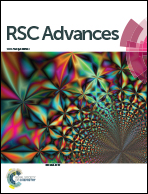Advanced yolk–shell hydroxyapatite for bone graft materials: kilogram-scale production and structure-in vitro bioactivity relationship†
Abstract
This paper introduces a facile method for synthesizing a new structured hydroxyapatite [HAp, Ca10(PO4)6(OH)2] material, named “yolk–shell”, by a simple spray drying process. The spray-dried precursor powders, consisting of Ca and P salts and dextrin, are transformed into powders of yolk–shell HAp by a simple combustion process under an oxygen atmosphere. For comparison, filled-structure HAp powders are prepared by spray pyrolysis in the absence of dextrin. A few small apatite crystals are found to be formed on the surfaces of the filled-structure HAp grains after 7 days of soaking in simulated body fluid (SBF). On the other hand, small acicular apatite crystals are observed on the yolk–shell grain surfaces after only 9 hours of soaking in SBF. The entire specimen surface is covered by numerous acicular and newly-formed hydroxyl carbonate apatite crystals after 1 day of soaking. These crystals are observed both at the outer and inner surfaces of the shell and the outer surface of the core. Inductively coupled plasma analysis shows that the dissolution of calcium and hydroxyl ions from yolk–shell HAp is notably increased compared with a filled-structure HAp. These results indicate that yolk–shell-structured HAp powders possess an enhanced in vitro bioactivity, which is encouraging for its potential use as a bone grafting material.


 Please wait while we load your content...
Please wait while we load your content...